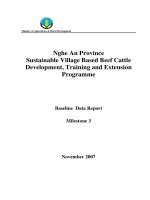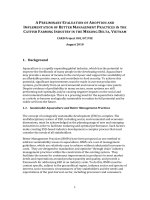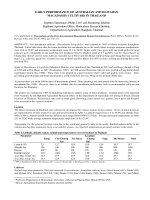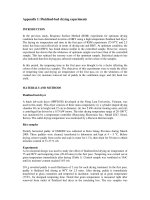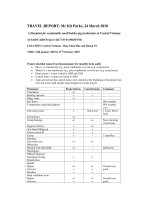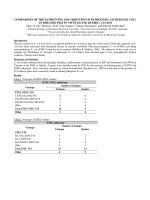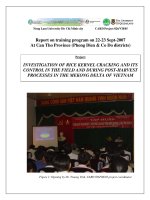Nghiên cưu khoa học nông nghiệp " A blueprint for sustainable smallholder pig production in Central Vietnam - MS10 " doc
Bạn đang xem bản rút gọn của tài liệu. Xem và tải ngay bản đầy đủ của tài liệu tại đây (28.39 KB, 3 trang )
Ministry of Agriculture & Rural Development
CARD Project Progress Report
004/05VIE
A blueprint for sustainable smallholder pig production
in Central Vietnam
MS10: ESTABLISHMENT OF FARMER CLUBS
Figure: Demonstration Farm 02007 Thua Thien Hue. Pure Mong Cai sow with
11 healthy 5-day-old F1 piglets.
1. Institute Information
Project Name
A blueprint for sustainable small holder pig production in Central Vietnam
Vietnamese Institution
N
ational Institute of Animal Husbandry (NIAH); Hue University of
Agriculture and Forestry (HUAF); National Institute of Veterinary Research
(NIVR)
Vietnamese Project Team
Leaders
Dr Ta Thi Bich Duyen (NIAH); Professor Nguyen Quang Linh (HUAF);
Dr Cu Huu Phu (NIVR)
Australian Organisation
The University of Queensland/Victorian Department of Primary
Industry/South Australian Research and Development Institute
Australian Personnel
Dr Darren Trott, Dr Ian Wilkie, Dr Colin Cargill, Dr Tony Fahy
Date commenced
April 1st 2006
Completion date (original)
April 2009
Completion date (revised)
April 2010
Reporting period
Milestone 10
Organisation
NIVR
Email:
2. MS achievements
Detailed report on the establishment of Mong Cai breeding Zone in the central provinces including:
a) Physical structure of 40 smallholder cooperatives
b) Organisational and management structure for establishment and sustainability of a large scale
breeding zone (incorporating 40 smallholder cooperatives)
c) Breeding and CIP programs
d) Responsibilities for monitoring of physical and financial performance during the project and
beyond
Evidence:
a) Formation of Farmer Clubs in Quang Tri and Thua Thien Hue
The formation of three farmer clubs in Quang Tri in October 2008 (following outbreaks of
FMD and PRRS) was a major project initiative developed by Dr Duyen from NIAH (See
appendix 1-Establishment of farmer clubs for details on the clubs’ activities). Two farmer clubs
were formed in the Hai Thuong commune (An Khe and Thuong Xa) and one in the Phu Hai
commune (Phu Hung).
Around the same time as the farmer clubs were being formed in Quang Tri, informal gatherings
of smallholders farmers and commune centred around the most successful farmers were
occurring in Thua Thien Hue. These have now evolved into farmer clubs.
In October 2009, Dr Darren Trott visited each of the farmer clubs and took part in the first
anniversary celebration of the farmer club activities in Quang Tri (see appendix 2-Trip report Dr
Darren Trott). He also made visits to the most successful farms in Thua Thien Hue (Phan Hue
and Thuy Phuong communes; Mrs Tran Thi Tuyet, Mr Nguyen Van Lap and Mr Nguyen Tan
Phuong).
Dr Darren Trott’s visit also provided an opportunity to meet with the project farmers and the
commune veterinarians responsible for delivering veterinary services. Discussions of the major
pig diseases encountered within each commune assisted the creation of training programmes for
farmers and also provided the opportunity to deliver a tutorial on appropriate and judicious use
of medications for a range of pig diseases in which the veterinarians and the project farmers
were the major participants.
Antimicrobials and antiparasitic drugs covering the major production diseases were supplied to
each club, with the commune veterinarians demonstrating how to deliver the medications in co-
operation with demonstration farmers.
Since the formation of the clubs, it became apparent that the farmers had grown in knowledge
and awareness of the major pig diseases. For instance, all farmer groups were more aware of
coccidiosis and specific treatments, but owing to the high cost of the Bayer anticoccidiostat
(Baycox) and the reduced prices for pigs experienced at the time, some farmers could not justify
the cost of using Baycox as a preventative and were taking their chances, relying on good
husbandry to keep their piglets free of disease.
The farmer clubs are the perfect basis to form the large breeder collective by providing the
nucleus of successful smallholder farmers who will be able to supply breeding stock to the
region. For the anniversary celebration the farmers gathered at a central commune and took part
in a farmer quiz competition. The farmer clubs worked in their groups and each had to choose a
mystery question covering three major themes of Mong Cai pig production. The groups were
given time to discuss the answers amongst themselves and a group spokesperson then delivered
their considered answer to the entire auditorium. A panel of experts scored the answer on its
accuracy and relevance and the best team (based on answers to three questions) won a prize.
This exercise developed team cohesiveness within the farmer clubs but also a sense of project
ownership. The effectiveness of the farmer groups was apparent during Dr Darren Trott’s visit
as farmers displayed greater knowledge on pig diseases, animal husbandry and profitability
compared to the mid-project farm visit.
b) Creation of DVD (Lessons in Pig Production from Farmer Clubs in Central Vietnam)
Under the direction of Ms Tarni Cooper and the project team members from each Vietnamese
Institute (with technical assistance from Dr Kit Park), the farmer clubs took responsibility for
developing a training DVD. A copy of the DVD (English and Vietnamese versions) has been
delivered to the CARD programme office and should be viewed in conjunction with this report.
The DVD covers nine Chapters, with each chapters corresponding to a high priority project
intervention strategy that had been introduced on project farms. The DVD is to be used as a
basic introduction to important aspects of pig farming in central Vietnam, with farmer groups
meeting to cover 1-2 Chapters at a time. Each of the farmer clubs were responsible for
delivering 1-2 Chapters. The process began in December 2009 with basic storyboarding
exercises, followed by filming in January 2010. Each commune was responsible for
developing the storyboard to introduce each topic. A very important aspect of the DVD was that
it not only included those project farmers that had been selected by the project for infrastructure
upgrade and training, but also the next generation of farmers (ie those living nearby) who were
just beginning to take on board some of the recommendations.
Production of the DVD represents the culmination of everybody’s efforts to achieve a
successful project and a lasting legacy. It is anticipated that further project funding from NGO
sources will be sought to continue this programme as well as assess the effectiveness of the
DVD as training tool in farmer to farmer training initiatives.


